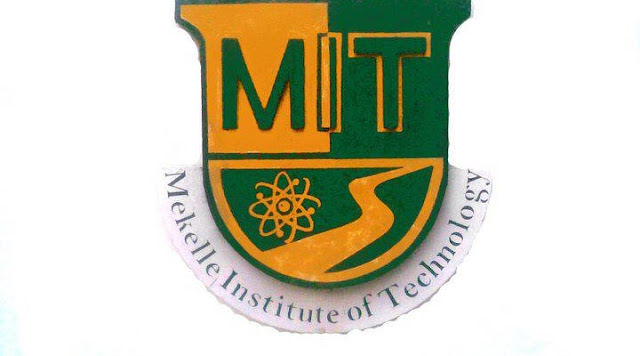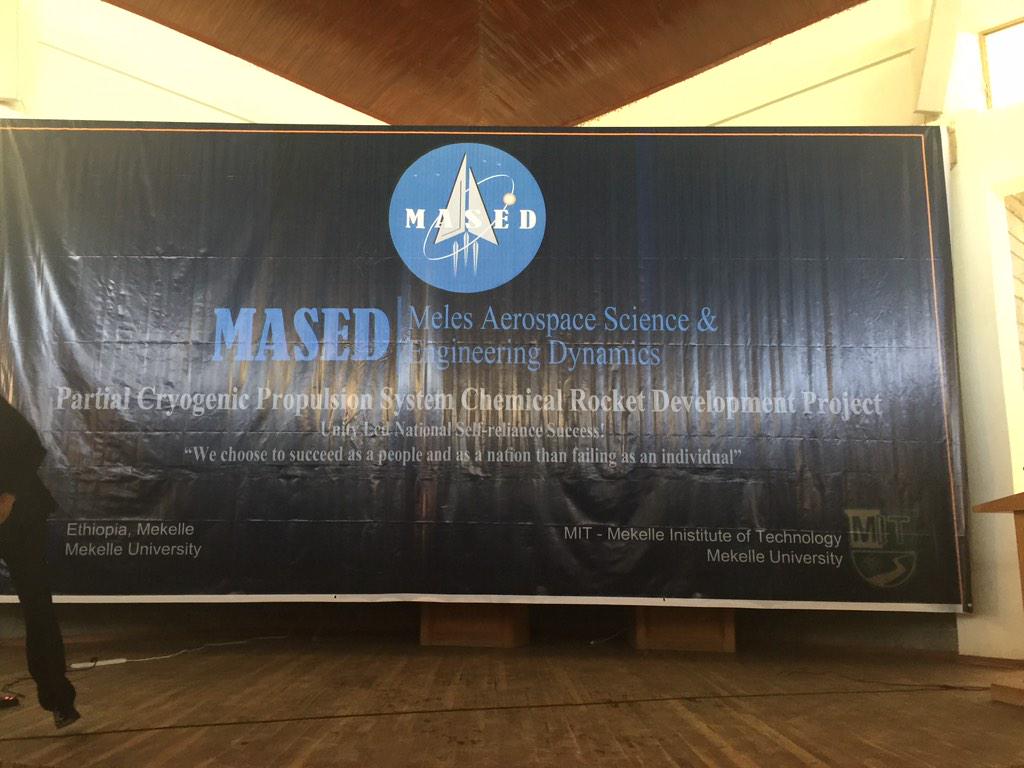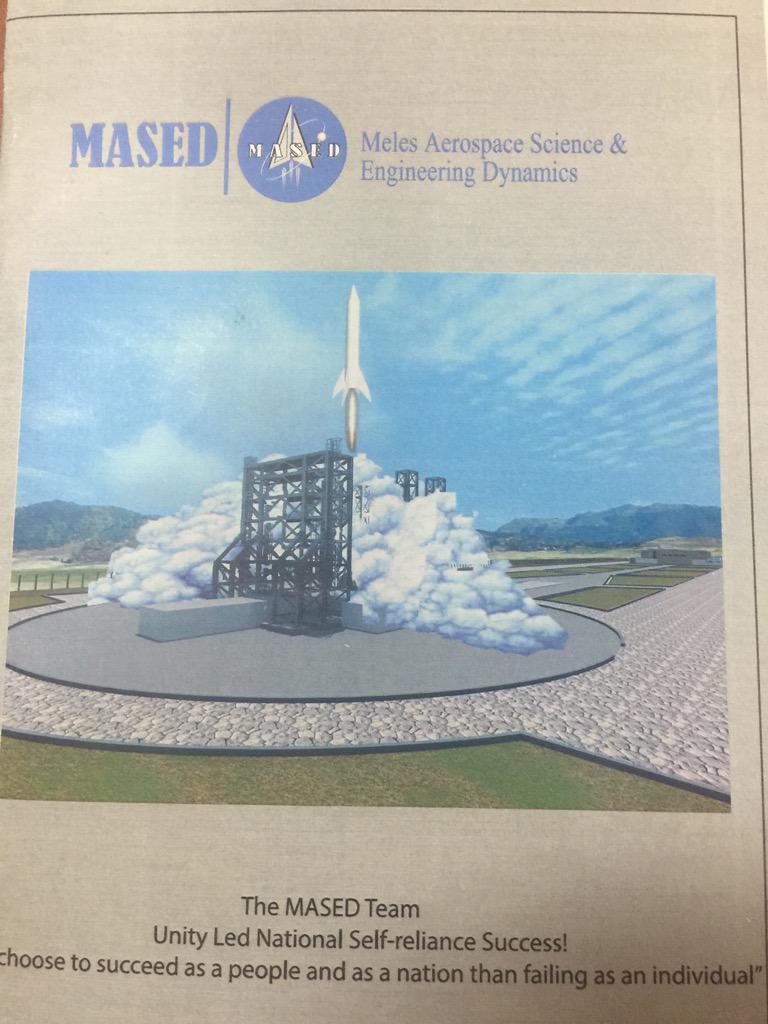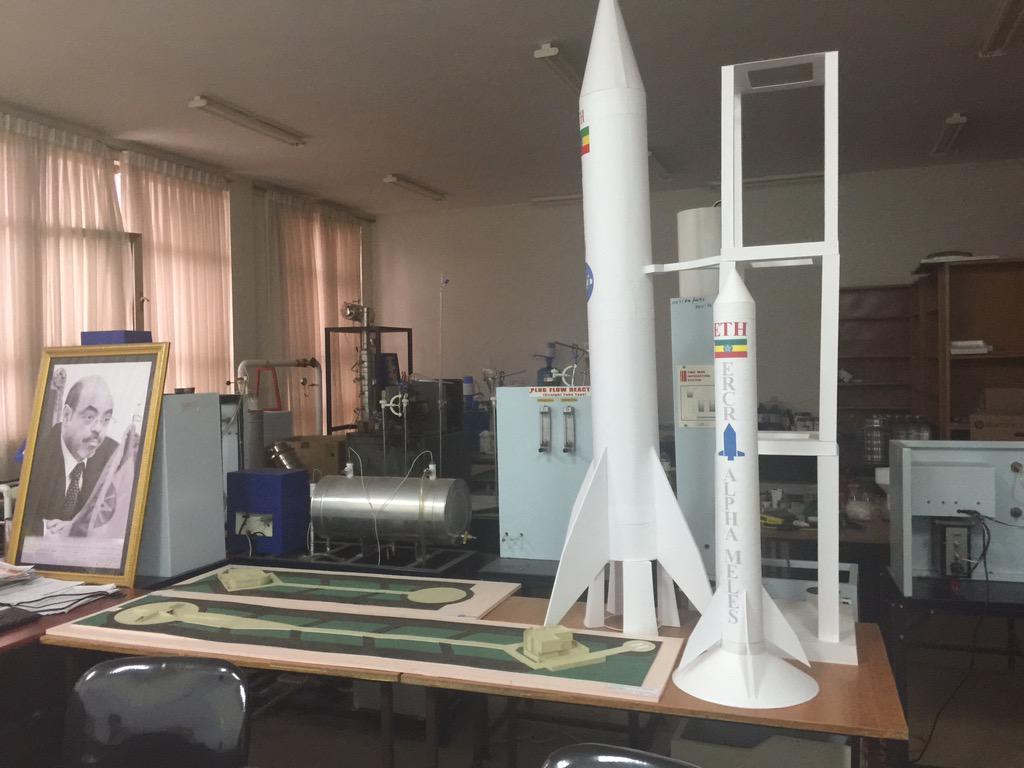Soheil_Esy
Fazanavard فضانورد
- Joined
- Apr 5, 2015
- Messages
- 744
- Reaction score
- 19
- Points
- 18
July 7, 2015
Students of Mekelle Institution of Technology, Mekelle University have designed Alpha-Meles liquid fuelled Bipropellant Rocket and are finalizing preparations for its November 2015 launch. The Hashenage Station is located in Northern Mekelle. The sub-orbital rocket will reach 30km altitude. Alpha Meles is named after the late Prime Minister Meles Zenawi. Testing for the system and capacity of the rocket to be launched will be finalized in two underground stations until the end of the month of July 2015. Sixty engineers drawn from various fields are working day and night for the success of the project. Parts of the station are fabricated locally by Mesfin Industrial Engineering and Mesebo Cement, local private companies and the Metals and Engineering Corporation (METEC), the stated owned military industry.

https://www.facebook.com/hahulelusite/posts/470962859731525
Students of Mekelle Institution of Technology, Mekelle University have designed Alpha-Meles liquid fuelled Bipropellant Rocket and are finalizing preparations for its November 2015 launch. The Hashenage Station is located in Northern Mekelle. The sub-orbital rocket will reach 30km altitude. Alpha Meles is named after the late Prime Minister Meles Zenawi. Testing for the system and capacity of the rocket to be launched will be finalized in two underground stations until the end of the month of July 2015. Sixty engineers drawn from various fields are working day and night for the success of the project. Parts of the station are fabricated locally by Mesfin Industrial Engineering and Mesebo Cement, local private companies and the Metals and Engineering Corporation (METEC), the stated owned military industry.

https://www.facebook.com/hahulelusite/posts/470962859731525
February 19, 2015
Presentations on progress review of Meles Aero space science and Engineering Dynamics (MASED) project Alpha-Meles partial Cryogenic Propulsion system: liquid-Fuelled Bipropellant chemical project was held on Feb 19, 2015 at Mekelle Institute of Technology, Mekelle University.
rocket
His Excellency Ato Amin Abdulkadir Minster of culture and Tourism, Professor Mitku Haile former president of MU and Minster Councillor for Ethiopia to UNSECO France, and other guests were visited the projects and handed over the presentation overall progress of the project.
After Dr. Kindeya Gebrehiwot president of Mekelle University welcomed the guests coordinator of the project Mr.Mulualem Hailemariam said “The project is managed by Ethiopians, mainly students and Stuff of MU with the vision inspiring the present generation, with the beauty of science and Engineering adventure in order to compete in the era of innovation, science and technology to Advancement of the country. It has also good opportunity to minimize the dependence of Ethiopian researchers on the others. The Rocket is on implementation and the team is well motivating to finalize as its design without any dynamic effects. He also added that the Rocket projects have high demands, finance and it requests high contribution With Federal and Regional Governments.
The Expansion of the ground control static station is to be Build in two sites, in main campus of the University and at around Hashenge lake, Southern Tigray. The project has Experience sharing with Addis Ababa, Adigrat University, Ethiopia Space Science Society, Mechanical aspects with Mesfin Industrial Engineering, demand aspects with Mesebo cement Industry, Machew particle board and Ethiopia Air Force. The project consists of different expertise Organized in different disciplines and has active female members.






Model rockets and model of the two ground testing stations
https://www.facebook.com/MITethiopia/posts/642927585835810
Kyutech Scientist visited EORC
07 May 2015.
An Astronautical Engineering Scientist from Kyushu Institute of Technology (Kyutech),Japan visited EORC
Dr.John Polansky, who is deputy manager of Kyutech’s HORYU-4 nano-satellite project and responsible for project based learning(PBL), international collaboration and outreach at Kyushu Institute of Technology (Kyutech),Japan, visited EORC on April 24, 2015 based on the joint collaboration of satellite development & research program between Entoto Observatory & Research center (EORC), Ethiopia and Kyutech, Japan.
During his visit Dr.John gave public lecture for EORC & AAIT engineering staff and students on Satellite technology in general and space Engineering program at Kyutech in particular.
In his first talk 'about satellite and satellite technology', Dr.John has briefly described about satellite and its application in general for different purposes such as communication, remote sensing and Navigation. He then continued discussing about the current status and development of Nano-satellites and its advantage in terms of low cost investment.
He underline the advantage of small-satellites over big satellites for countries like Ethiopia who are located in a geographically advantageous position in utilizing space with low cost in investment, launching, and development period. He explained the advantage of nano-satellite development technology by stating that though a single nano-satellite by itself cannot do anything as compared with larger size however a number of small satellites known as constellation of satellites can do a lot with large area coverage and continuous access. He further mentioned that there are only two places on Earth that can achieve continuous coverage and access with relatively low cost with single orbital plane: polar region and equatorial region such as Ethiopia.
In his second talk he briefly described about the newly launched English based Space Engineering International Course (SEIC) of master and Phd training at Kyushu Institute of Technology (Kyutech) since 2013. He explained that the postgraduate program is project-based learning (PBL), and on-the-job training in space environment testing and open for any student, Japanese or non-Japanese, who registers as a full-time graduate student at the Graduate School of Engineering.
Dr.John further gave updates of the United Nations/Japan long-term fellowship program on SEIC and Nano-satellite activities at Kyutech and he clearly clarify how Ethiopian Engineering student can be benefited from this program in terms of scholarship ,student exchange, short-term trainings and internship.
Dr.John summarized his talk by saying that Ethiopia's geographically location is very good in developing satellite and utilizing satellite services and he put forward the ideas of developing equatorial constellation nano-satellite as a best strategy to start satellite development in Ethiopia with low cost investment. He finally said that his institute (Kyutech) is keen in helping Ethiopia in satellite development program by training students and staffs of EORC in space engineering at kyutech and want to scale up their collaboration to run their program jointly with EORC in future.
http://www.eo.org.et/index.php/8-home/81-an-astronautical-engineering-scientist-visited-eorc
EO and STSG sign MOU on Satellite Development
01 September 2014.
MOU agreement signed between Entoto Observatory and Research Center (EO) and Space Technology and Science Group (STSG) to train, to develop, to build and to launch medium research satellite at Entoto observatory and Research Center.
Entoto Observatory and Research Center has been established in 2013 by 32 Public universities, Ethiopian Space Science Society (ESSS) and one private University as an independent and autonomous institute.
The main Objective of EO is: to provide for the promotion and use of Earth Observation, Satellite technology, Astronomy, Space Science and related technology, activities, foster research and long and short term training of internationally competitive expertise in Space Science and its applications, advances scientific knowledge through Human Capital, support the creation of an environment conductive to industrial development in Astronomy, Earth observation, Satellite science, Space Science and related technologies with in the frame work of national government plan as well as to make Ethiopia to be competent in science and technology and to catch up the rest of the world that have space science and satellite technology program, said Dr. Solomon Belay Tessema director of the observatory.
Therefore, the main objective of satellite development agreements is one of vision of the observatory and to develop, build, launches 20-25 Kg medium research satellite within the next five years. After the evolution of the first project both institutions will further upgrade the agreement into large scale satellite technology development.
http://www.eo.org.et/index.php/8-home/64-mou
15 August 2014
Earth Observation Division
In this research division, research will be done in Gravity, Global Navigation Satellite System (GNSS), Optical, hyper-spectral and Radar Remote Sensing to investigate earth’s system integral components like geosphere, atmosphere, hydrosphere and biosphere.
Geodetic Research Group
The research areas of this group focus on physical and geometric geodesy to study the Earth's shape, size and dynamicity. Research in physical geodesy studies the physics of earth's gravitational field to determine geoid and theory of geopotential height systems,temporal gravity field variations and its applications to global mass distribution and transport, oceanography and geodynamics.
Geometric geodesy aims to use Global Navigation Satellite Systems (GNSS) to define,maintain and provide a highly accurate, consistent and stable geodetic reference frames that can be potentially used for surveying, positioning and navigation. The research in GNSS geodesy extends to studying the time and space variations of position coordinates of Continuously Operating GNSS Reference Stations to identify subtle deformation of the solid earth.
Our geodetic group's future priority areas is to expand research in other space geodetic techniques including Interferometric Synthetic Aperture Radar (InSAR), Altimetry and Satellite Laser Ranging for better understanding of the Earth system.
Remote Sensing Research Group
The research activities of the remote sensing research group is to integrate geospatial,GPS, optical, and radar earth observing remote sensing satellites datasets to study the most pressing environmental and atmospheric issues including forestry and ecosystem,agriculture, climate change and adaptation, geology, hydrology, geo-hazard, land use/land cover, urban planning and development, cloud and fog cover, oceanography and Planetary and cosmology applications. The future research priorities of remote sensing research group are to establish ground satellite data receiving station, receive and archive remotely sensed data for early-warning and real-time planetary system components monitoring,assessment and forecasting system.
http://www.eo.org.et/index.php/research-and-technology/2012-07-30-05-19-45/2014-02-11-12-46-53
Identifying China's Successors
July 30, 2013
The arcs along which nations rise and fall vary in length and slope. China's has been long, as far as these things go, lasting for more than 30 years. The country will continue to exist and perhaps prosper, but this era of Chinese development — pyramiding on low wages to conquer global markets — is ending simply because there are now other nations with even lower wages and other advantages.

https://www.stratfor.com/weekly/pc1...TE:|*&;utm_content=Decade Forecast: 2015-2025
Last edited:
